This is an article about flipping furniture for money.
This post may contain affiliate links, which means I’ll receive a commission if you purchase through my link, at no extra cost to you. Please read full disclosure here.
If you have a furniture flipping business, then you know it can be an exciting and lucrative side hustle, or even become a full time job. We started our business flipping furniture and selling vintage decor, and within about six months we had a five-figure business. You can pretty easily go from nothing to a few hundred dollars per month. But how do you make money flipping furniture for a real profit, earnings thousands per month, every month?
Furniture flipping for money requires taking it seriously, if you want serious money.
Flipping furniture for a hobby is totally fun–we used to pick up curbside finds just for fun. Repainting a chair, or picking up some thrift store decor, and selling for $20 or $50 is a hobby. But if you want to start making enough money to improve your lifestyle, you have to shift your strategy–and attitude.
Tip 1: It’s a furniture flipping business. Not a flippin’ hobby. So act like it.
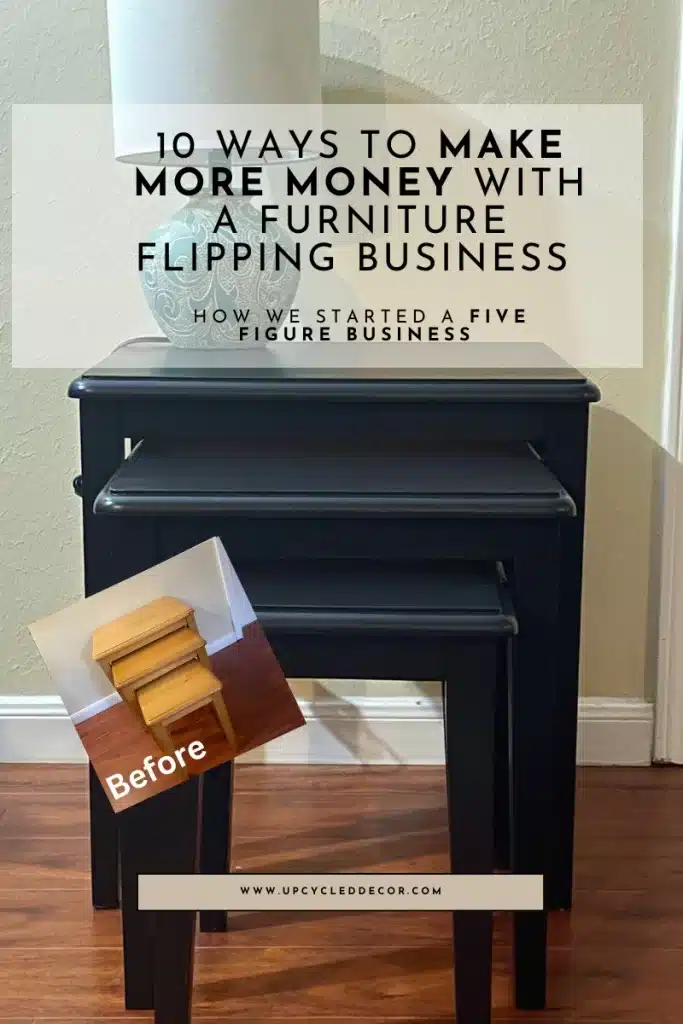
Please save! And share!
Seriously. Act like this is your business, and you rely upon it to pay bills, go on vacation, quit your day job. A hobby you can put down when you’re bored or tired. A business requires you to show up, even on days when you don’t want to. Flipping furniture for profit is no different than any other business. For us, it was super fun, for like, three months.
Then you break something because you’re tired, or hammer your own nail because you’re tired or don’t want to go to garage sales because you’re… Or someone leaves a bad review or says it looks damaged or wants their money back because their kid didn’t like it (!).
It’s a job. It’s a flippin’ job. We learned way more in the unpleasant moments than we did in the easy days. Business habits you build when things are easy and fun is not scalable. Systems built when you’re broke and tired will see you through most challenges.
Tip 2: Schedule your time. And always think about your ROI.
When we started our furniture flipping business, we had a schedule for, like, everything. Every minute you’re doing one thing, you’re not doing something else. When you scale, you can begin to outsource. But at first, your time it binary. If you’re thrifting, you’re not painting. When you’re painting, you’re not listing. If you’re listing, you’re not selling. If you’re selling, you’re not thrifting.
This is a real time management with a business like flipping furniture. We once missed a sale because we were at a great estate sale. But, over time, we learned that sometimes the ROI made sense to skip the sale.
Sometimes, a $20 sale wasn’t as profitable as picking up great estate sale finds at $2 a piece. Initially, we’d run to every potential meetup, hoping to make a sale. But, estate sales are not as frequent as garage sales and better inventory than thrift stores. If we didn’t sell that chair for $20, and it cost us $5, we’re still only out $5. But let’s say we found several great pieces at the estate sale. The final profit might be several hunddred dollars.
We created schedules around:
- when we went to thrift stores (which locations, dates and times were best)
- a planner for curbside find: which neighborhoods, which days were bulk pickup (we have a curbside planner here that you can download for free!)
- garage sale routes: where to go first (you can only be first at one sale–which will be most useful?)
- when we would be available to meet customers
- how often we would update inventory
When you make this kind of thoughtful plan, it really does change your productivity. You learn to make it a part of your routine. (And, yes we read Atomic Habits, which was such a game changer in our work discipline.)
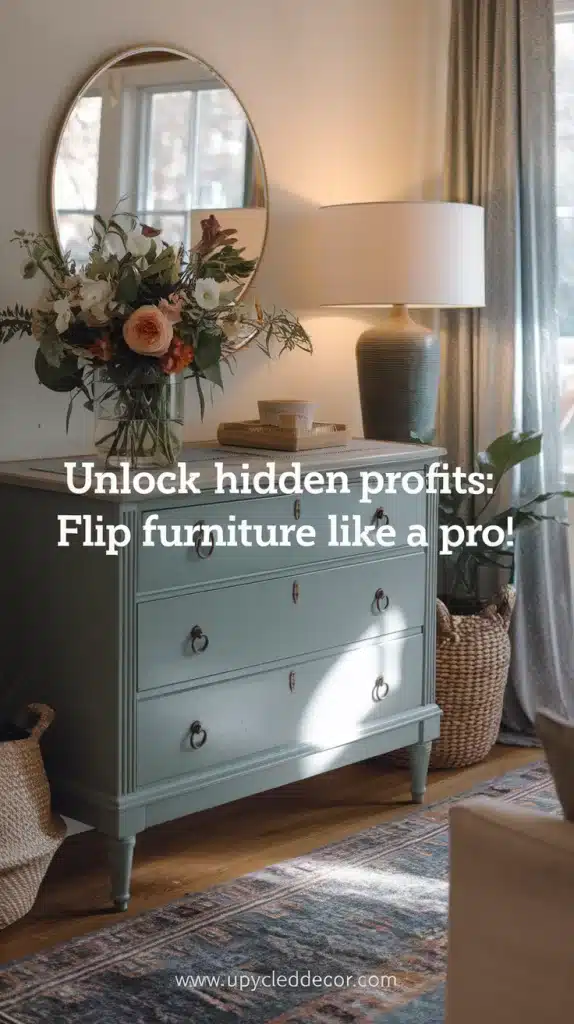
Tip 3: Do research–and create your own data
There are tons of articles like this on how to make money selling vintage decor and flipping furniture. Read them. Seriously–start flipping furniture as a beginner, but also learn what other people have already figured out. Like any other business, you will make more money with this business if you mix your own experience with courses or lessons or tips.
But even if you are watching a ton of YouTube or TikTok furniture flipping superheroes (no judgment), the most important research is your own. When you first start flipping furniture, you will make mistakes. You will have to sell things for cheap or take a loss. You will break things and damage things. Yeah, it sucks. But you also need to learn from these mistakes. Try not to see every misstep as a catastrophe. We really did find better ways of painting, sanding, cleaning, pricing, marketing–all because of mistakes.
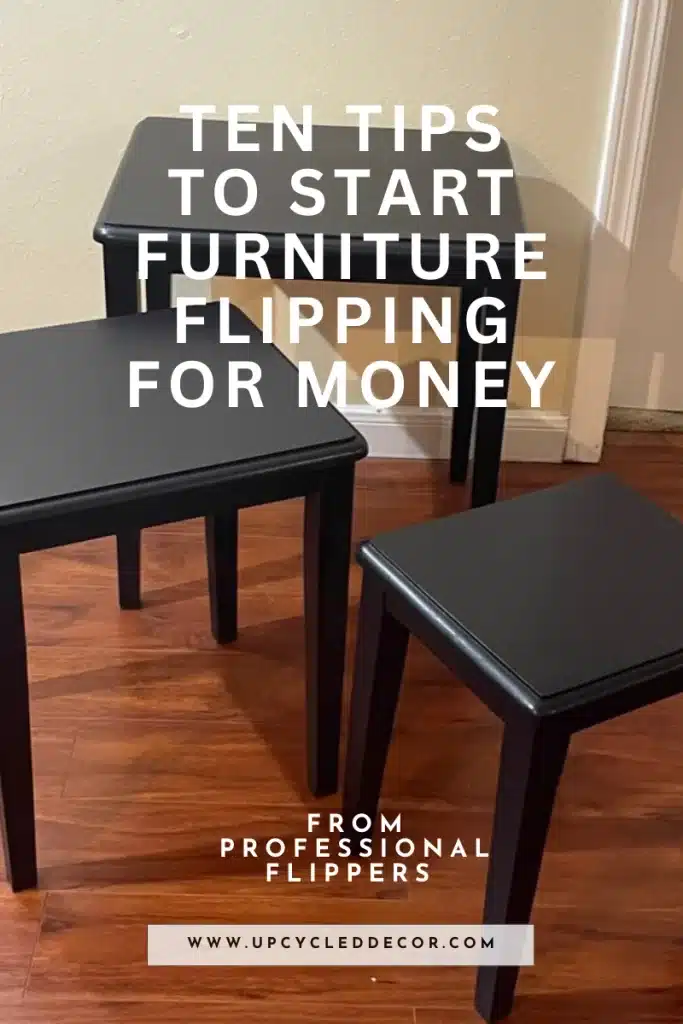
Don’t forget to save and share!
Furniture flipping beginners should set goals to make a profit reselling thrift furniture.
Tip 4: Have non-financial goals for your furniture flipping business.
Not all small business goals have to be financial. Start off with things like painting better or faster. Through research and trial-and-error, develop a list of your 5 favorite thrift stores or 10 best neighborhoods for garage sales. Doing things cheaper is a great early goal.
But some cheap fixes are actually more expensive over the long run, or aren’t scalable. Related, you may need to make small investments in your business to test what’s working. While we are ALL for being cheap in the beginning, we learned that small purchases either saved us money, or helped us increase profits.
On the other hand, learning do things faster will always be cost effective. The faster you can turn your inventory over, the more you will make in the short run. Over time, the more you can outsource (efficiently), the more you will make.
We have written about this before but this is why we think furniture flipper beginners shouldn’t do full scale furniture makeovers. We call our makeovers, maintenance (a little nightstand Botox, not a facelift). It takes a long time to fully makeover furniture. The cleaning, stripping, sanding, priming, painting of it all. We strongly suggest you learn a way to make a decent profit fast, while you practice those skills.

We wrote about how much fun we had with this easy chair makeover using upcycled shower curtains to re-upholster. But be sure to read how fast we did it to make more money!
Tip 5: Aggressive but achievable financial goals make you take your furniture flipping business seriously.
Have financial goals for your furniture flipping business also. increase revenue at first. Then you want to start increasing profit. Bottom line (pun intended), you need to just make cash at first. Learn which products your market demands. Your first goal–don’t lose money. Seriously. Our first goal was to just make a small profit, even five dollars.
That meant we were doing a pretty good job of what we bought, and how we marketed things. And then over time, we continue to get better at pricing for the best profit. We push ourselves now to not only make a profit, but increase the profit. On top of that we have goals for how quickly we turn our inventory over, since that improves cash flow. If you want to make money flipping furniture, you have to treat it like a business.
But looking back, we set those goals too low. Yes, try not to take a loss. But the nice thing about flipping furniture (and decor) is you can find a pair of free chairs, clean them up and make something. So if you want to set furniture flipping business goals you need to aim higher.
We quickly learned that you can realistically make between $1000 to $5000 per month flipping furniture for money, within the first six months. We had a $1000 month, in month two. Yes, really. We made $3000 per month in month eight. Looking back, it feels like that took too long. We stumbled into that level of growth and probably could have hit that mark much earlier.
But what does that mean, seriously?
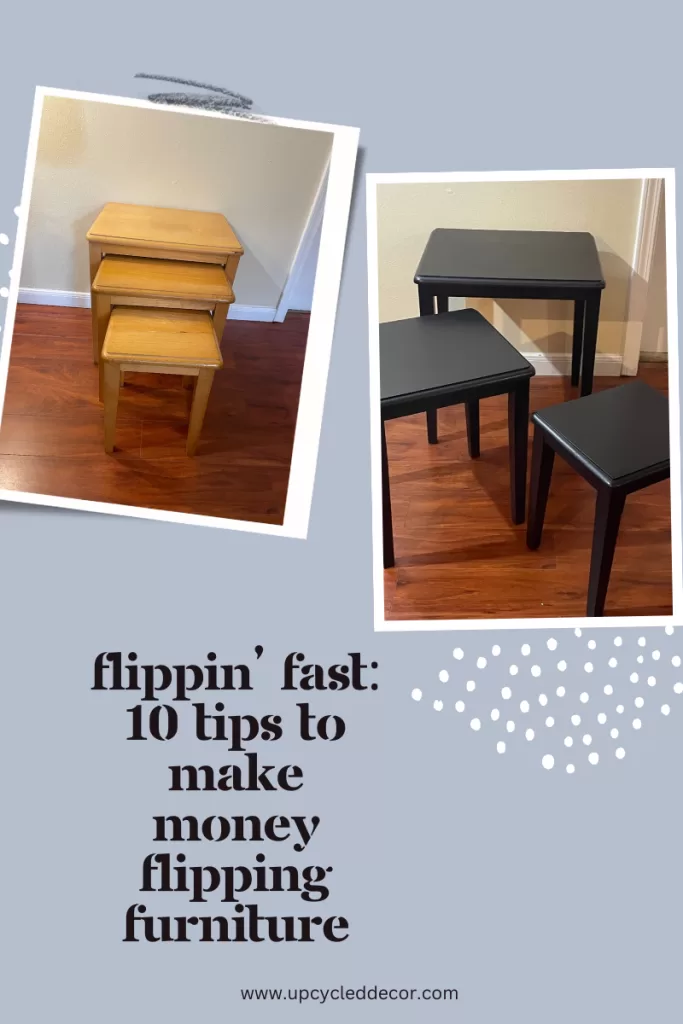
Flipping furniture can be fun and profitable–if you have a plan.
What else will help you start flipping furniture for profit?
So, attitude, mindset and goals. You can start making really good money flipping furniture pretty quickly–if you treat it like a job. There’s absolutely nothing wrong with reselling thrift store furniture for a hobby. We love to spend weekends carefully repainting a desk just for our own use. And if you like hunting around Goodwill for some vintage decor for your house already crowded with vintage decor, come sit by us.
But.
If you want to start flipping furniture for money, and you’re a beginner furniture flipper, you have to get out of the hobby mindset, even when it comes to those financial goals. You aren’t buying for yourself–which was hard to remember sometimes. Professional shopping: way less fun.
You can’t do it only when you feel motivated. Flipping furniture is hard, physical work. It is dirty, you can get injured (not seriously, usually) and it requires being smart about expenses and cash flow and all the other stuff of a business. So that $1000 month seemed really cool. But we weren’t thinking about expenses and cash flow and all that stuff.
So if you want to grow your flip furniture to $10,000 instead of $1,000, the difference is all that other stuff.
Here are more furniture flipping ideas to make more money.

This is the kind of fast and easy end table makeover that can help you flip furniture faster.
Tip 6: Understand seasonality, and economic trends in furniture flipping.
Most businesses have economic seasonal trends. Retail stores and Christmas. Accountants and tax time. Football players and… Ok, so for furniture flipping and seasons, you actually need to think about what people are, and aren’t doing.
Flipping furniture ideas by season. In most places, spring bring moderate temperatures. For us, that means it’s not yet the relentless Texan heat and so people have a lot more garage sales. The other thing is people tend to generally have a “spring clean” mindset and want to get rid of furniture. Fall can be similar–most places have cooled off (or not yet become freezing). Winter, especially closer to Christmas and hostile temperatures, means you’re better off at thrift stores. Summer is a mixed bag: if you live in a cold climate you might find more. We find less outdoors: it’s just too hot.
Furniture flipping ideas by calendar. Ok, this isn’t quite the same thing as shopping by season, but flipping furniture has a buy and sell seasonality due to the natural flux of times of year. By late spring, college students will graduate–a good time to grab free stuff. But also a great time to sell: lots of people moving to first apartments, or have just arrived in a new city and looking to buy a lot in a short time before starting a job.
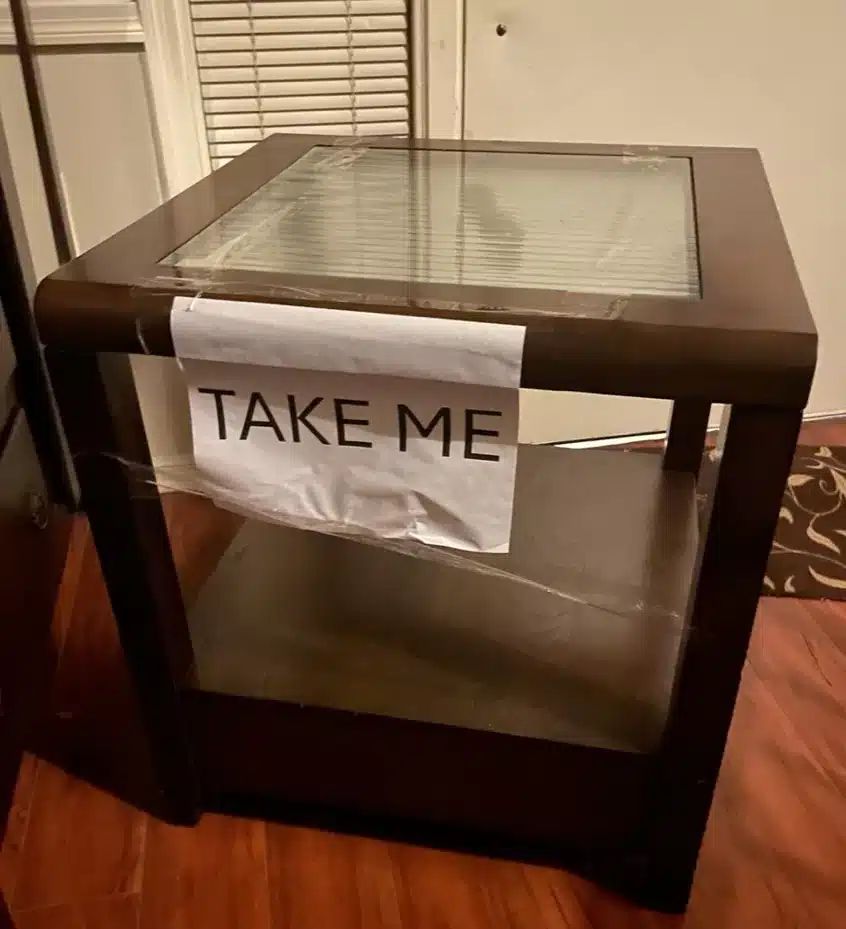
We took it. (Then sold it.) Curbside finds are a great way for beginners to start flipping furniture for money.
Also, families tend to move between June and August to avoid moving children mid-school year. It’s a great time to shop moving sales. We find the selling slower in the summer, though. Most of the buyers are newcomers to the area. In the fall, normal traffic picks up. The holidays can be hit or miss–we find we sell vintage decor a lot more than furniture. Read more here about how to sell vintage decor.
Learn that your customer comes first.
Tip 7: Learn which furniture flipping ideas attract your customers
That isn’t a big existential question. It’s just that you need to know who your customer is. Our market revolves around two markets: vintage decor buyers with a high end budget and bargain hunters shopping economically.
In other words, we have customers who will pay top dollar for just the exact vintage item we have. And, we have customers who are looking for practical things at a discounted price. The first buyer might pay top dollar for the exact Longaberger Pottery pie dish they want. The second buyer might be prepared to repaint a pair of worn but solid wood nightstands.
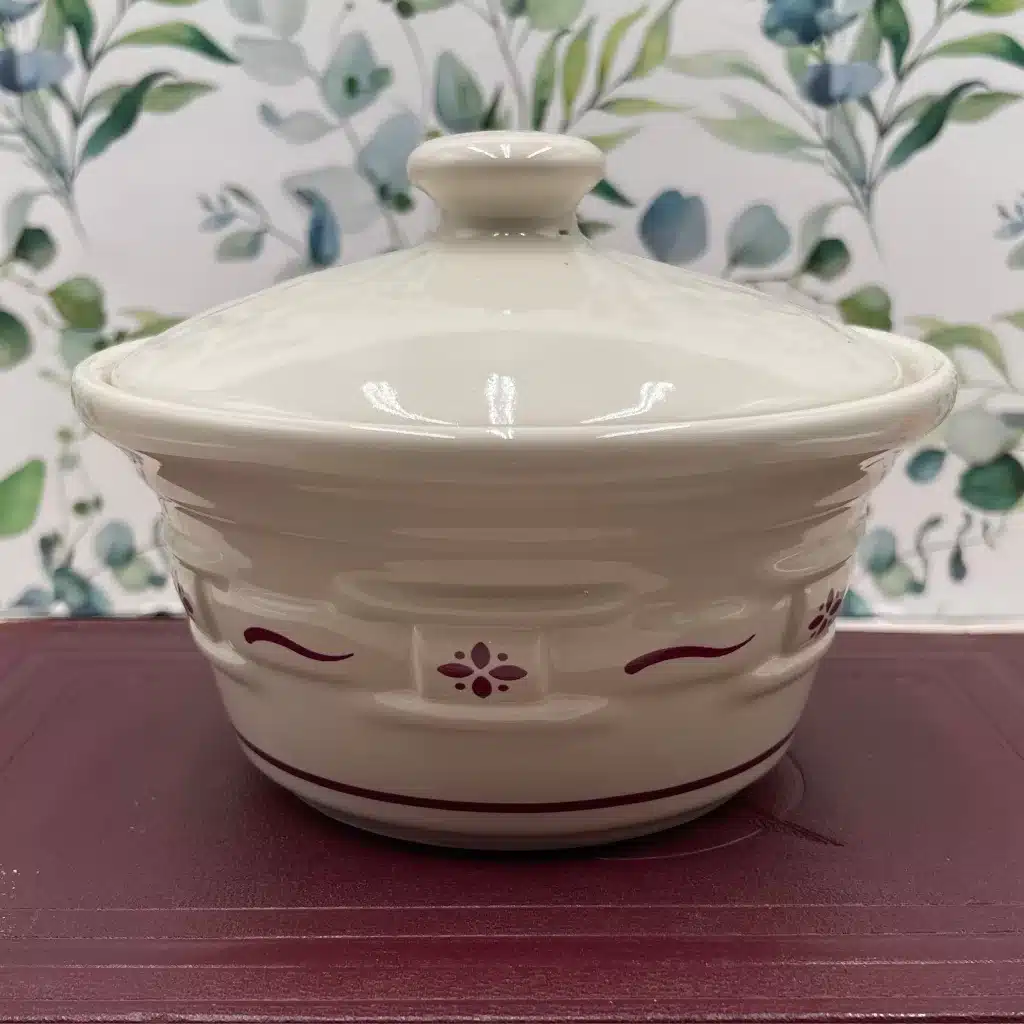
People are serious about their vintage pottery. Read more about Longaberger Pottery here.
This matters because you might need to segment your furniture flipping strategy. For example, you might want to specialize in high end vintage antiques for one customer set and budget-friendly solid wood curbside finds to another. Eventually, you should segment even further. Do your vintage decor customers prefer certain types of items (lamps or teapots) or certain styles (MCM or Hollywood Regency)?
Tip 8: Invest in your business.
While we started with nothing, and were super scrappy when we started, we also put profits back into the business. Learn when you’re being cheap and not smart. In fact, sometimes being cheap was actually more expensive. For example, we used to use spare Solo cups to hold our paint. Super scrappy.
But these Handy Paint Pails were no more than a couple packs of Solo cups and yet it was sturdier, didn’t crack and held the brush out of the paint because it has a magnet built into the side. We’ve literally had two for years and never replaced them. Actually cheaper, and less messy. Invest in what will save you time and is durable.
Part of the secret to success in the furniture flipping business is to treat it like a business.
Most people paint a couple chairs or makeover a nightstand, and then begin to dabble in flipping furniture. So did we! The problem with flipping furniture for beginners is most people stay in the hobby mindset way after they have decided they want to start flipping furniture for profit. Any time you move something from a passion project to a profit-making one, you have to actively change your perspective.
Tip 9: Practice, but adapt: you will make more money with small changes.
Like all small businesses, you need to be equal parts scrappy and strategic. If you are a beginner furniture flipper, you will need to test different ideas in your market. You need to learn the seasonality and the customer profile. It might feel extreme, but this is how we grew our own furniture flipping business to five figures in less than a year.
Every time you learn something useful, look for an opportunity to use it. Leverage lucky moments.
Adaptation takes a lot of discipline. Humans like routine. If what we’re doing now is even almost as good as a new idea, we stick with the old idea. But over time, you won’t have lots of easy big wins. The first sale, the first $100, the first $1000: those are exciting. But you can only do them once.
Eventually, you will increase profitability with small improvements. Improving your margin at the small scale is the exact opposite from the large scale. Think about it: If you bought a chair for $10 and sold it for $20, you doubled your money. 200% of your original investment.
But, dude. It’s $10 profit.
If you are making $5000 per month, and you find a way to improve your revenue by 10%, that’s an increase of $500. The more money you are make, the bigger the ROI on small improvements.
Tip 10: Have fun flipping furniture. No, not just because it feels good. You’ll make more
So have fun! But be serious. No, really you can have a lot of fun flipping furniture for money. It’s just that you have to now enjoy the business of reselling furniture, and not just the kickass fun art of it. And while we wish you good mental health, the fun isn’t just to feed your soul.
People are more productive doing something they enjoy. You might not like every moment. But if you are fundamentally interested: because it saves the planet, or saves your savings, find a connection to it. The creativity but also the numbers.
Be curious about how to improve financially. That means being smart with finance, understanding some business fundamentals of flipping furniture and working at it like it’s…your job.
Please share and save!
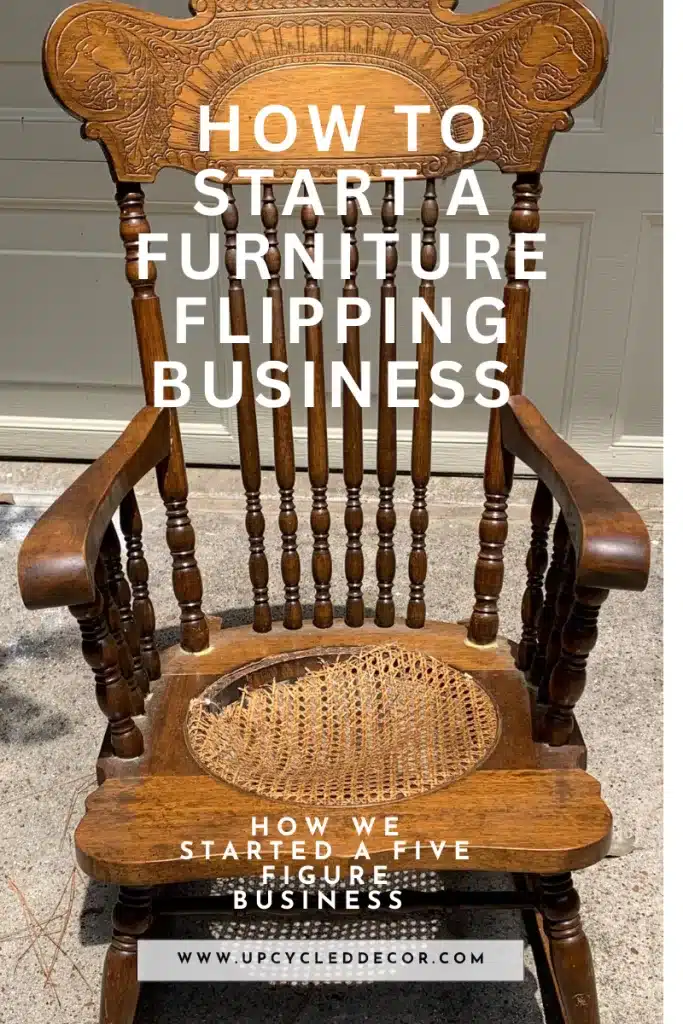
For more articles on flipping furniture ideas, read about how we started flipping furniture with zero dollars and went to thousands per month.
If you want to learn how we make money selling vintage decor, read more here. And to find great buys at estate sales, check out our estate sale shopping tips article here.
This was an article about flipping furniture for money.

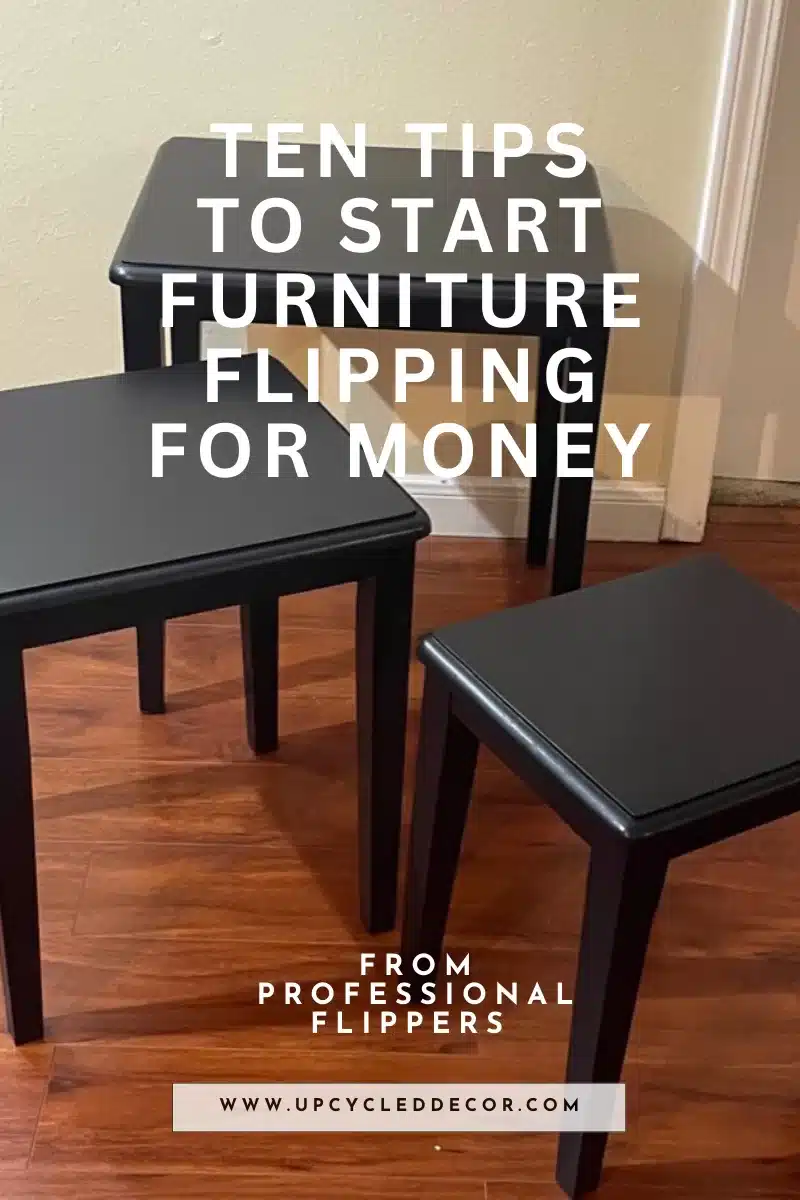


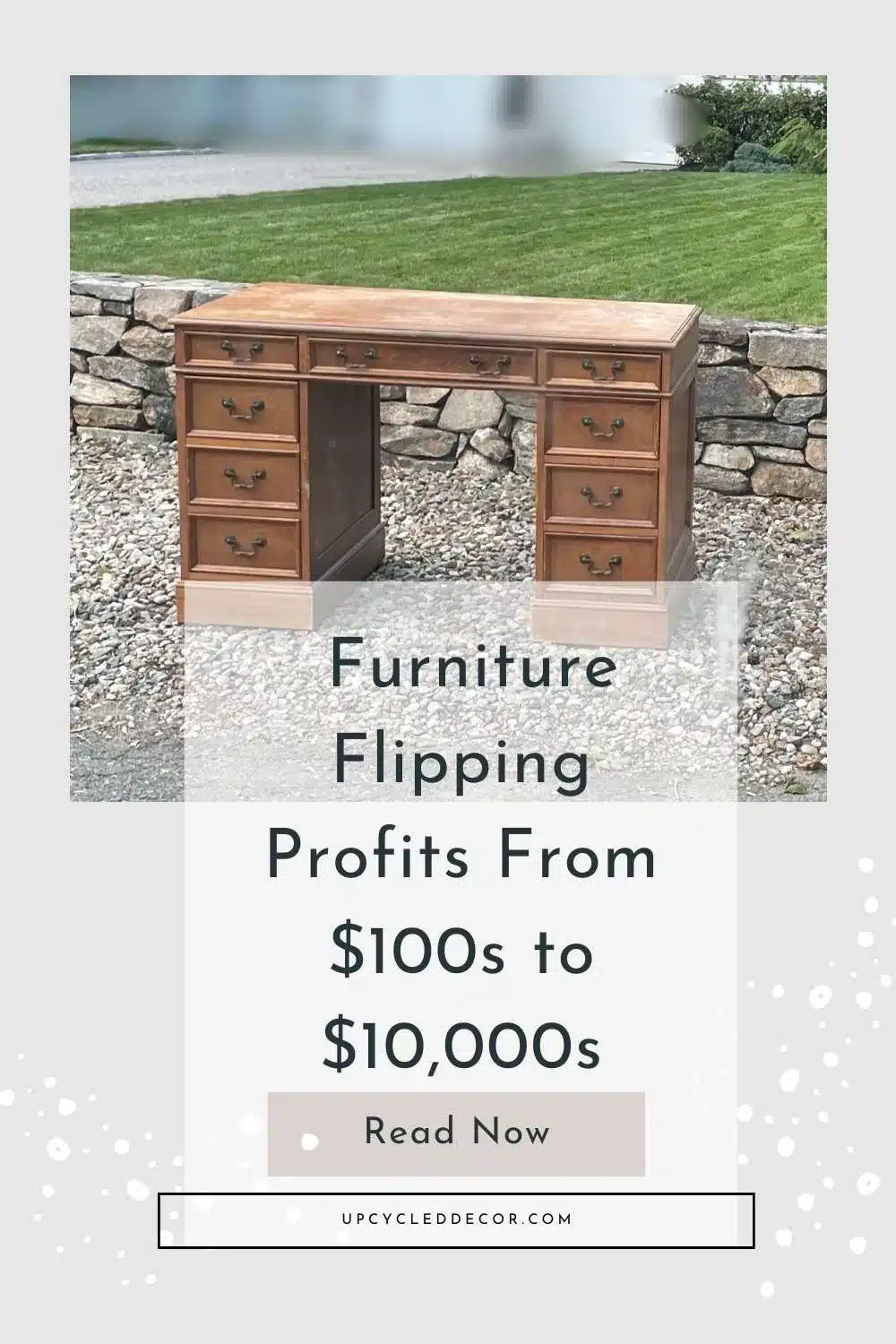
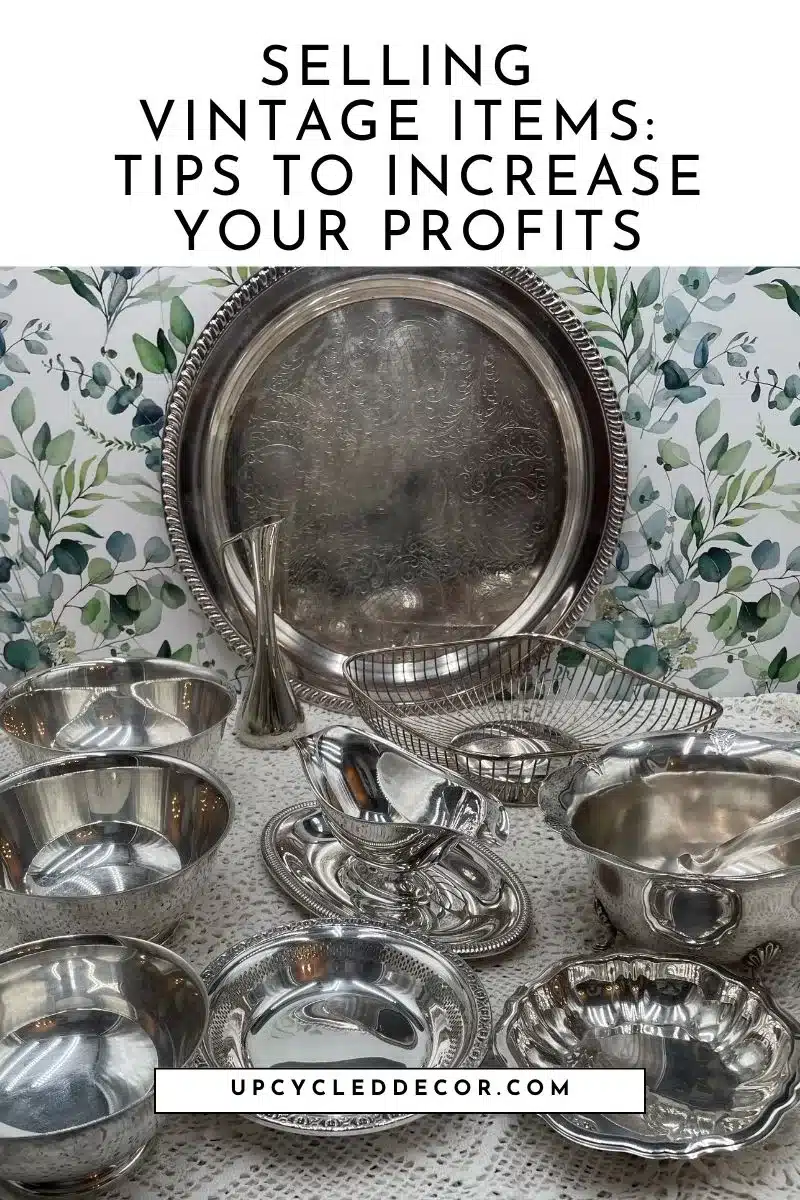
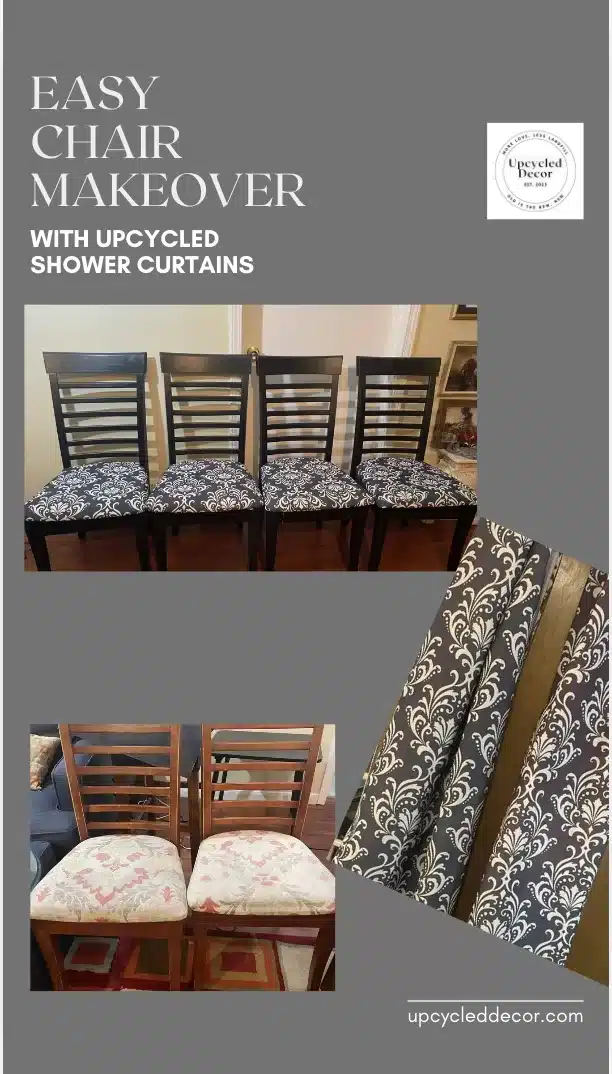



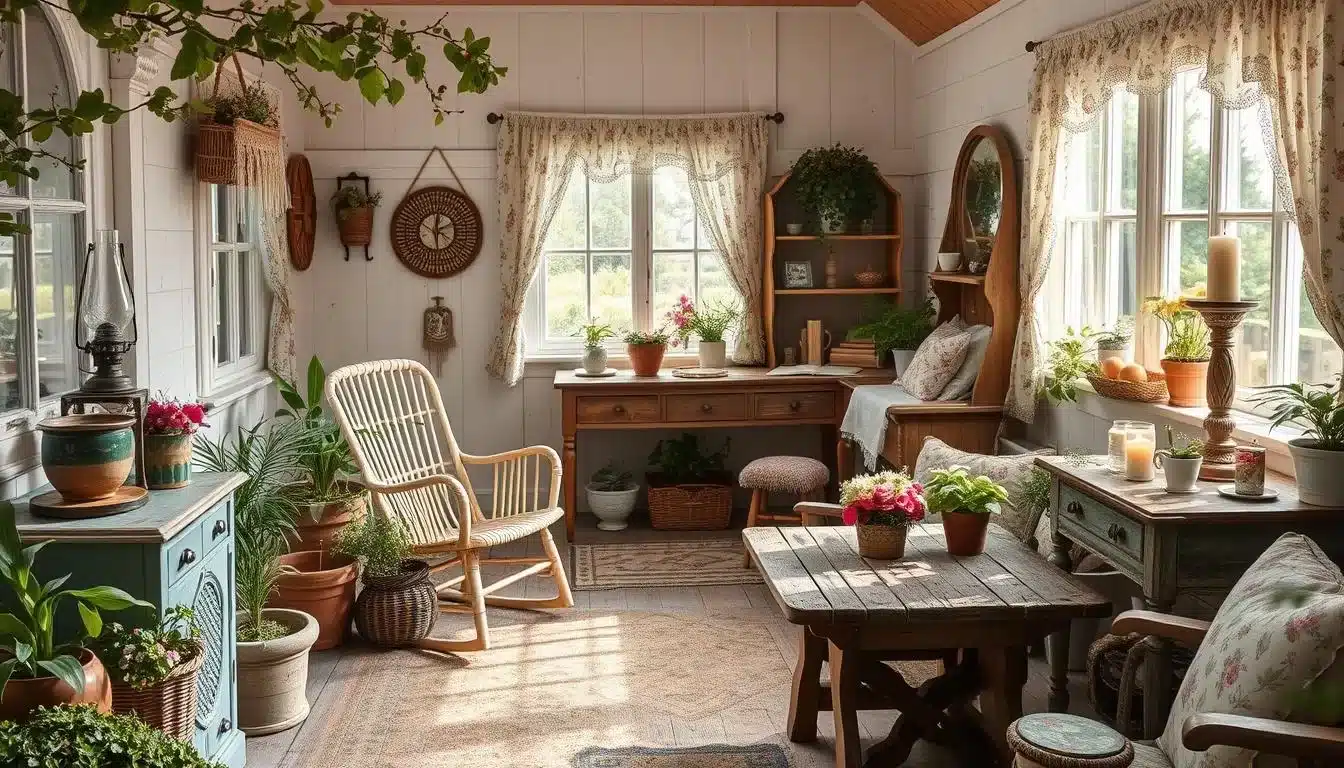


Recent Comments